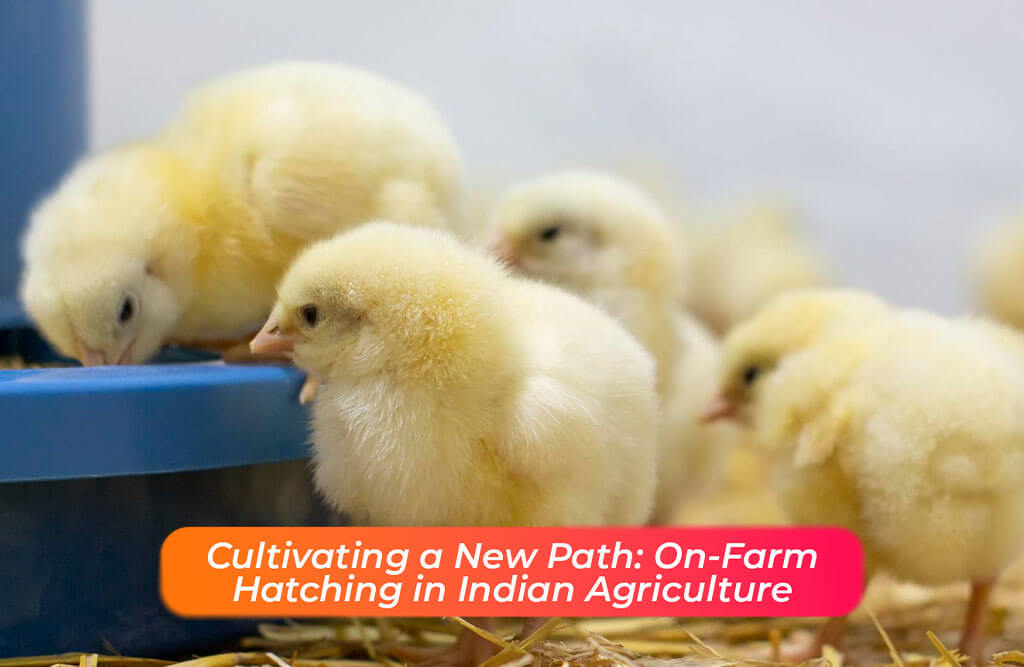
A new innovation in modern poultry production has the potential to increase productivity, reduce antibiotic use, and enhance flexibility in the supply chain. This technique can provide an opportunity to avoid the stress of handling and processing small chicks throughout the day, which could be crucial for Indian agriculture.
Transporting live animals poses a significant challenge for animal welfare. During transportation, animals often lack basic necessities such as food, water, climate control, or even proper handling, leading to elevated stress levels, especially in adverse weather conditions. Poultry farming, particularly the transportation of day-old chicks over long distances, is not exempt from this challenge.
Support for On-Farm Hatching: On-farm hatching emerges as a new trend in Indian agriculture protection, that can address this issue. This technique enables the direct transportation of small chicks from the hatchery to the fields, thus saving them from negative impacts.
Post-hatch processing and transportation-free: On-farm hatching allows immediate access to food and water for small chicks, benefiting animal welfare and production efficiency. When a small chick can start eating immediately, it may experience rapid weight gain, potentially leading to an increase in weight by up to 4.4%.
Improved internal development: Immediate access to food and water improves the internal development of small chicks. Additionally, the combination of hatching and transportation without encountering pathogens can significantly reduce the need for antibiotics.
Enhanced prevention of pod dermatitis: Continuous improvements can be observed in the rate of pod dermatitis, a condition characterized by a skin lesion on the foot pad. This improvement can contribute to maintaining public health.
Increase Productivity: On-farm hatching streamlines the hatching process, potentially leading to increased productivity. By directly transporting small chicks to the fields, the time and labor involved in the hatching process are reduced, resulting in additional savings for producers.
Flexibility in the Supply Chain: On-farm hatching has the potential to enhance flexibility in the supply chain. This can assist in maintaining regular and dedicated production, enabling farmers to make better decisions in managing their resources.
Labor Conservation: Before adopting on-farm hatching, producers must face some potential challenges. While on-farm hatching saves labor in the hatchery, some of this labor needs to be fulfilled on the farm. Farmers need to maintain precise climate control before and during the hatching process, and sometimes, additional investment in climate control may be required.
Identification of Eggs or Unhitched Chicks and Humane Euthanasia: Farmers also have the responsibility of identifying eggs or unhitched chicks and euthanizing them in a humane manner, which is crucial for maintaining high welfare standards.
Extension of Grow-out Period: To terminate hatching for farmers, it is necessary to extend the grow-out period by approximately three days. This ensures proper development of the eggs and healthy chicks.
Incompatibility with Other Hatchery Processing Steps: On-farm hatching may be incompatible with other hatchery processing steps, such as beak treatment, vaccination, or sexing. However, some of these steps can be eliminated or transferred to in-ovo solutions.
Farmers need to carefully navigate these challenges to ensure the successful implementation of on-farm hatching and enjoy its potential benefits in terms of labor efficiency, improved welfare standards, and increased flexibility in the poultry production process.
Innovation in Agriculture: The mention of “on-farm hatching” suggests a new perspective or innovation in Indian agriculture. Exploring new technologies and methods is crucial for the progress and sustainability of the agricultural sector.
Diversification of Agricultural Practices: The introduction of on-farm hatching signals the diversification of agricultural practices. This diversification can lead to increased productivity, improved crop yields, and the adoption of a more resilient agricultural system.
Technological Advancements: The use of terms like “hatching” indicates involvement in New Technology. Technological innovation can play a significant role in modernizing agriculture, making it more skillful and environmentally friendly.
Economic Impact: Initiating any new direction in agriculture can have an economic impact. It may create new employment opportunities, increase farmers' income, and contribute to the overall economic development of a region or country.
Food Security: Direct changes in agricultural practices, such as on-farm hatching for poultry or other livestock, can have a direct impact on food security. If on-farm hatching contributes to boosting the production of poultry or other animals, it can support meeting nutritional needs and addressing concerns related to food security.
Government Initiatives: Discussion about on-farm hatching may involve considerations of any relevant government initiatives or policies. Government support and policies can influence the adoption and success of new agricultural practices.
On-Farm Hatching in Indian Agriculture:
The importance of a “new direction” in agriculture, with the implementation of on-farm hatching, has positive implications for agriculture, the economy, technological advancements, and food security. Additionally, it is crucial to consider the environmental and governmental aspects while putting this new direction into practice.